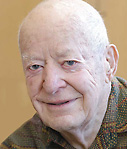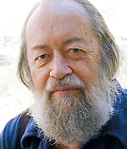Wayne Hazen
Wayne Hazen, professor emeritus of physics, died Aug. 30 at the age of 96.

Photo by Jens Zorn.
A native of Michigan, he received his Bachelor of Science from the Massachusetts Institute of Technology (MIT) in 1936 and his doctorate from the University of California at Berkeley in 1941 in cosmic ray physics as a student of Wallace Brode. He served on the Berkeley physics faculty until coming to U-M in 1947, where he remained throughout his career. Although he retired to emeritus status in 1984, he continued to be an active contributor to the Department of Physics. He chaired the doctoral thesis committees of 14 students, many of whom have gone on to prominent roles in space physics and other areas of science.
Hazen’s early research at Berkeley involved determining the mass, spin and other properties of the then-recently discovered mu meson (muon). Together with Professor A.Z. Hendel at the research station on Mount Chacaltaya in Bolivia he studied the radio pulses (10-100 MHz) produced by cosmic ray air showers, determining their polarization and spectra. Another significant research finding of Hazen was seeking to duplicate and subsequently to disprove the Australian claim for the discovery of free quarks (particles with electric charge of one-third that of an electron or proton) in a cloud chamber. He continued his studies of cosmic ray air showers at many sites around the world throughout his career.
He thoroughly enjoyed his professional interactions with colleagues and his travels around the world, friends say. He held a Guggenheim Fellowship at MIT in 1947, and again at Imperial College (London) in 1954; he also was a Fulbright Scholar at the Ecole Polytechnique (Paris), 1953-54. In 1958-59 he was the Smith-Mundt Professor at the American University in Beirut, Lebanon, and in 1966 he served as a consultant to the Agency for International Development Summer Institute in India. In 1972 he was a visiting professor at the University of Leeds (England), where he began a collaboration with Professor A.L. Hodson. In the 1980s he undertook an experimental collaboration with cosmic ray physicists in Western China. His global travels with his family were extensive.
Hazen’s love of adventure and exploration were unsurpassed; he was energetic and on the move well into his 90s, friends and family say. He enjoyed hiking, skin-diving, windsurfing, skydiving, skiing and flying (he had a pilot’s license). He constructed a significant portion of his family home and cottage, and also three wooden boats; his household engineering exploits were legendary, friends say.
He is survived by his wife of 71 years, Jean Hazen of Ann Arbor; children Sue Lillie of Denver, Gretchen Hazen of Anchorage, Alaska, Virginia Hazen of Casper, Wyo., and Eric Hazen of Brookline, Mass.; seven grandchildren; and five great-grandchildren.
— Submitted by Carol Rabuck, Department of Physics
Alan Howes
Alan Howes, professor emeritus in the Department of English Language and Literature, died July 9. He was 89.

Photo by Jens Zorn.
Howes received his Bachelor of Arts in 1941 and a Master of Arts in 1943, both from Middlebury College. After serving as an instructor at Middlebury, he served in the U.S. Army and the U.S. Civil Service in Japan from 1945-48. He became fluent in Japanese and maintained a lifelong interest in Japanese culture and art. At the time of his death, Howes was working on a book about the Japanese filmmaker Akira Kurosawa. He taught at the University of Connecticut and as a guest professor at the Yokohama National University, before receiving his doctorate from Yale University in 1955. He joined the U-M faculty that same year and moved through its ranks to full professor in 1969. Howes taught at the university until 2001, retiring at age 80.
Throughout his career, Howes was devoted to his students and especially loved training future teachers, colleagues say. In 1975, along with Professor Walter Clark, he founded the New England Literature Program (NELP), co-directing and teaching each spring in New Hampshire from 1975-90. He then taught for many years as a guest lecturer at NELP. The program remains in place as an intellectually and developmentally challenging enterprise for U-M undergraduates.
Howes’ major scholarly contribution is “Yorick and the Critics: Laurence Sterne’s Reputation in England,” published by Yale University Press in 1958 and reprinted by Archon Books in 1971. This contribution is supported and extended by briefer accounts of Sterne and by a later volume, “The Critical Heritage Series: Laurence Sterne,” published in 1974. He also contributed to the pedagogy of language and composition by co-editing “Literature for Adolescents,” published in 1975, co-editing “The Norton Reader” (eight editions from 1965-92), and by co-authoring “Language and Reflection,” published in 1992.
Howes served the university and the profession in a wide variety of roles, directing the English Summer Institute and serving as a reader for College Board examinations, as well as being a consultant for National Public Radio’s “Performance Today” and to numerous high schools on matters of curriculum and pedagogy. His service to the Department of English was especially extensive. He was a key figure in the department’s administrative structure, and his programmatic commitments have been far-reaching; he was deeply involved with the undergraduate curriculum and with the joint program in English and education.
His commitment to pedagogy, reflected in courses and programs, earned for him the Amoco Good Teaching Award, 1977; the Charles Carpenter Fries Award for contributions to the profession of English, 1983; the LSA Counseling Award, 1988; and the National Council of Teachers of English Award for Research in the Teaching of English (along with others as the co-author of Language and Reflection), 1992.
Howes is remembered as an avid outdoorsman, hiker, fisherman and gardener. As a friend described him, “He was full of ginger, and he lived a delicious life.”
He is survived by his wife of 52 years, Lidie; children Timothy (Nancy) and Marjorie (Paul); and grandchildren Zhi, Madeline and Alexandra. A memorial service took place Aug. 22 at the family’s summer home in Greensboro, Vt.
— Submitted by Anthony Cece, Department of English Language

